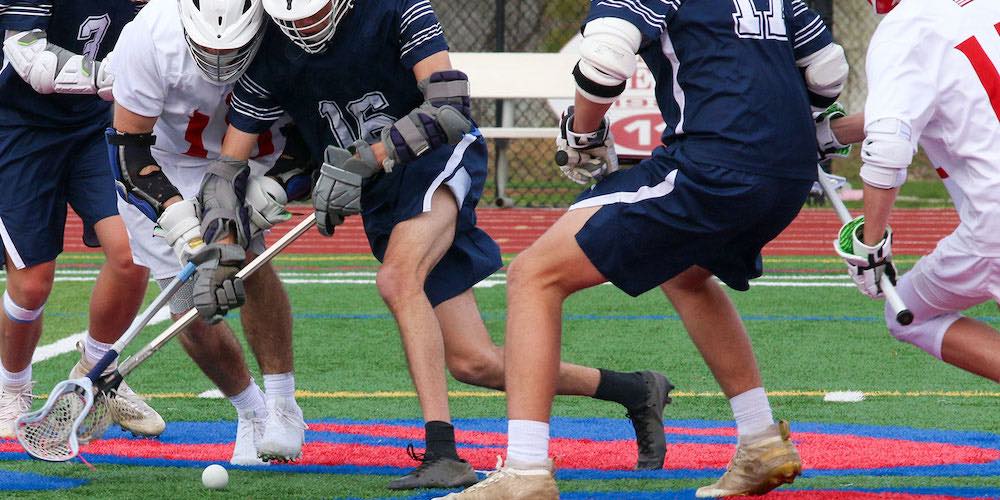How to Help Ensure Your Child’s Safety in Youth Lacrosse and Avoid Concussions

Youth lacrosse is a sport that combines speed, skill, and strategy, offering young athletes a dynamic and exciting experience. However, as with any contact sport, it’s essential to prioritize safety to ensure that the thrill of the game doesn’t come at the cost of the players’ well-being. This guide is dedicated to helping parents understand the risks associated with youth lacrosse and to provide simple ways that you can safeguard your young athletes.
Understanding the Risks of Youth Lacrosse
Recognizing the physical risks is the first step in creating a safe playing environment for your young athlete to ensure sustainable, long-term enjoyment of the sport of lacrosse.
- Common Injuries in Lacrosse: The dynamic nature of lacrosse can lead to a range of injuries. Sprains, strains, and fractures are common due to the physical demands of the game. Ankle sprains may occur from sudden changes in direction, while wrist fractures can result from stick hits or collisions.
- Concussions in Lacrosse: Concussions are a rising concern in any contact sport, including lacrosse. These injuries can have long-term implications on a player’s health and well-being. Recognizing the signs of a concussion – such as headache, dizziness, or confusion – is vital for coaches, parents, and players. But fear not, there are many equipment manufacturers out there that can help gear up your young athlete for a safe experience.
The Role of Equipment in Player Safety
Proper equipment is necessary for ensuring your young player’s safety in lacrosse. It’s up to parents and coaches to make sure that young athletes are equipped with the right gear so they can significantly reduce the risk of injuries and maximize the enjoyment of the game.
- Helmets and Head Protection: A well-fitting helmet is non-negotiable in lacrosse. It’s the primary defense against head injuries, including concussions. Helmets should meet safety standards, fit snugly, and be well-maintained. While budgets may be tight for some, we highly recommend investing in the perfect fitting helmet for young athletes given the propensity for collisions at early stages.
- Protective Gear: In addition to helmets, other protective gear such as mouthguards, shoulder pads, elbow pads, and gloves are becoming quite essential as the competitive nature of lacrosse grows in tandem with the popularity of the sport. They provide additional protection against impacts and falls, reducing the risk of fractures and sprains.
- Regular Equipment Checks: Regularly inspecting and maintaining equipment is crucial at every level of the game. Even the best gear can fail if it’s not properly cared for and we recommend that the parents of the young athlete clearly understand how to store and keep equipment in a way that it won’t fall victim to rotting or even mold. Regular checks ensure that all equipment is in good condition and that it provides the necessary protection for your child to pick it up and put it on with the same confidence they had the first time they wore it.
Concussion Prevention in Youth Lacrosse
Concussions are a serious concern in youth lacrosse, but proactive measures can significantly reduce the risk and ensure that any incidents are properly managed. As mentioned above, we highly recommend investing in a helmet that fits the young athlete perfectly.
- Recognizing the Signs of a Concussion: Education is key in concussion management. Coaches, parents, and players should be trained to recognize the signs of a concussion and understand the importance of immediate action, including removing the player from the game and seeking medical attention. As shocking as it may be to realize kids can be stubborn and put the enjoyment of the game over their own pain, education can help develop the right amount of caution should they experience a collision or fall.
- Safety Measures to Prevent Concussions: Proper technique, especially in tackling and checking, can reduce the risk of concussions. Coaches should emphasize safe playing techniques and enforce rules against dangerous plays. Additionally, strengthening neck muscles and improving balance can help players better absorb and recover from impacts. It’s silly to think that there won’t be intensity in a game like lacrosse, so encouraging your young athlete to start developing stronger muscles to help combat potential injuries can be very beneficial across the board.
- Creating a Culture of Safety: Encouraging open communication about injuries and symptoms, promoting fair play, and prioritizing player well-being over competition can foster a culture of safety while still maintaining the level of competition we know these young athletes aspire to play at. When players feel supported and heard, they’re more likely to report symptoms and take the necessary steps to make sure everyone on their team is playing at the highest of their abilities.
Training and Conditioning for Lacrosse Safety
Physical preparation is equally important for enhancing performance as it is for injury prevention. A well-conditioned athlete is more resilient and less prone to injuries.
Proper warm-ups and cool-downs are essential in preparing the body for the game and aiding recovery afterward. Dynamic stretching during warm-ups and static stretching during cool-downs can improve flexibility and reduce the risk of muscle strains.
Targeted exercises can build the strength and stability needed to withstand the physical demands of lacrosse. Core strength, in particular, is crucial for maintaining balance and preventing falls. Lacrosse requires quick, agile movements that can often only be developed through strenuous training on and off the field. In addition, incorporating balance and agility exercises into your young athlete’s training routine can drastically improve their ability to navigate the field safely and much more effectively.
Conclusion
In conclusion, safety in youth lacrosse is a collective responsibility. By understanding the risks, investing in the right equipment, implementing effective training and conditioning programs, and fostering a culture of safety and open communication, we can ensure that young athletes enjoy the game they love while minimizing the potential for injuries – offering the peace of mind that allows the parents to watch with enthusiasm.

